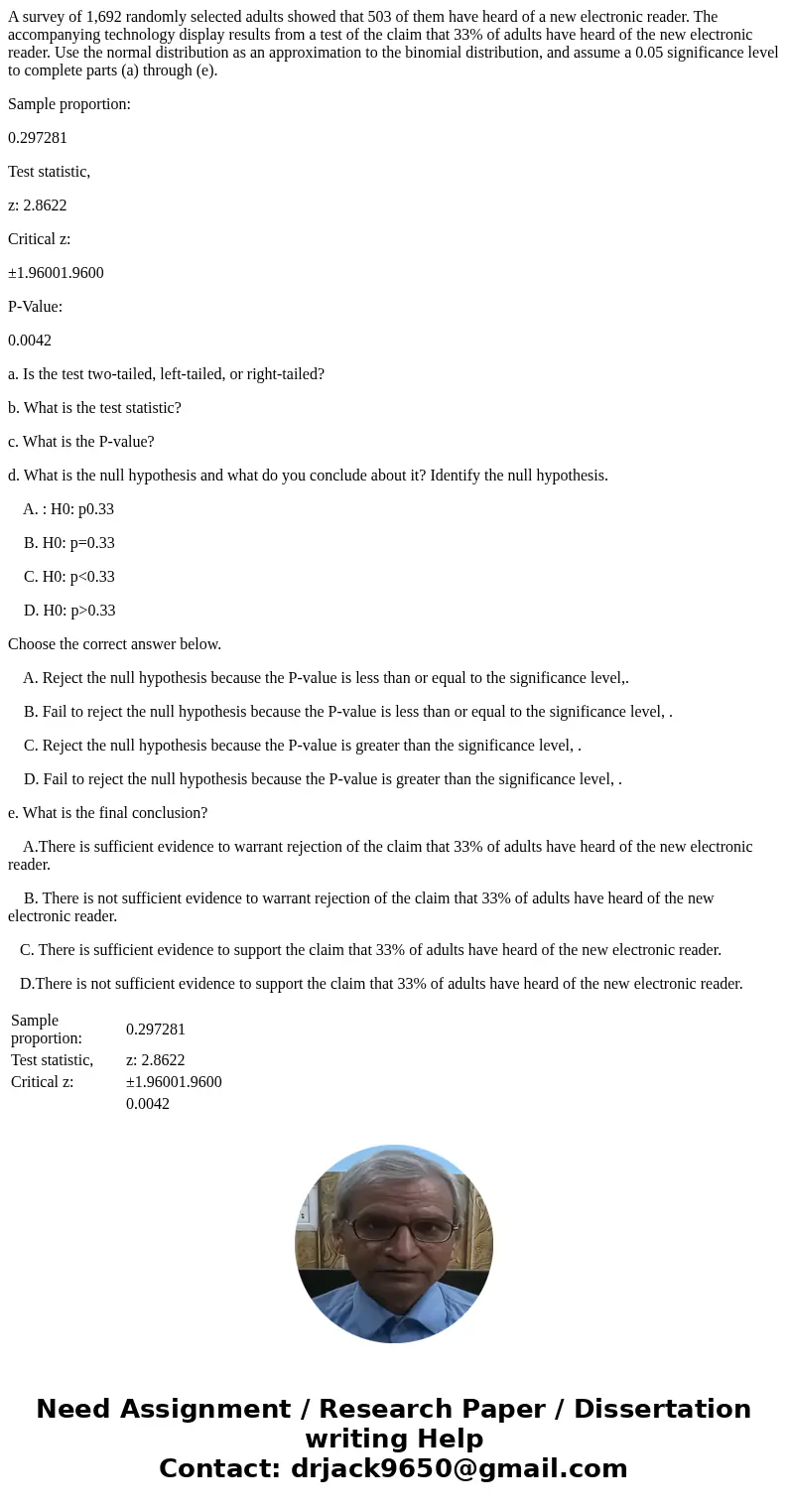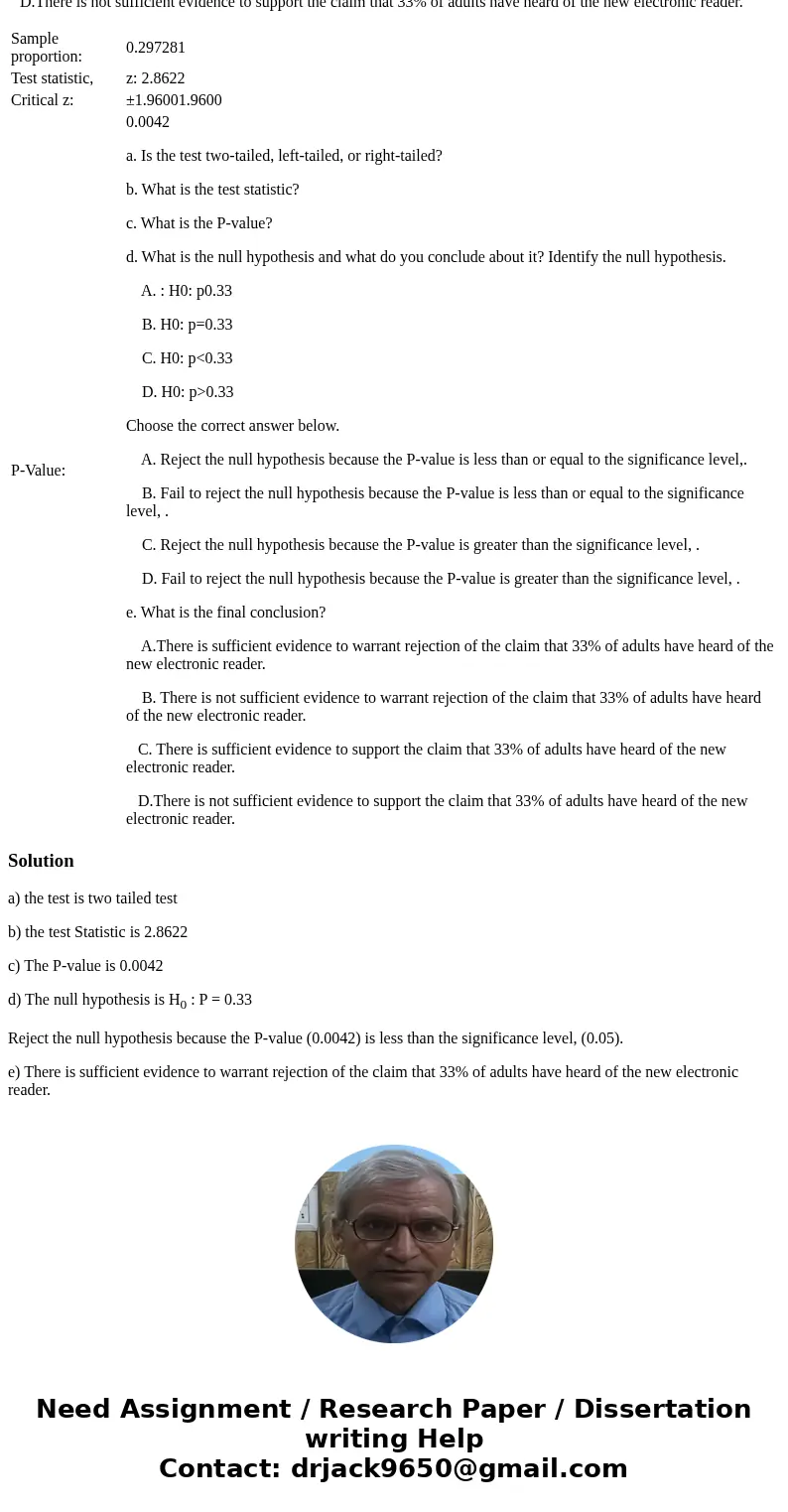A survey of 1692 randomly selected adults showed that 503 of
A survey of 1,692 randomly selected adults showed that 503 of them have heard of a new electronic reader. The accompanying technology display results from a test of the claim that 33% of adults have heard of the new electronic reader. Use the normal distribution as an approximation to the binomial distribution, and assume a 0.05 significance level to complete parts (a) through (e).
Sample proportion:
0.297281
Test statistic,
z: 2.8622
Critical z:
±1.96001.9600
P-Value:
0.0042
a. Is the test two-tailed, left-tailed, or right-tailed?
b. What is the test statistic?
c. What is the P-value?
d. What is the null hypothesis and what do you conclude about it? Identify the null hypothesis.
A. : H0: p0.33
B. H0: p=0.33
C. H0: p<0.33
D. H0: p>0.33
Choose the correct answer below.
A. Reject the null hypothesis because the P-value is less than or equal to the significance level,.
B. Fail to reject the null hypothesis because the P-value is less than or equal to the significance level, .
C. Reject the null hypothesis because the P-value is greater than the significance level, .
D. Fail to reject the null hypothesis because the P-value is greater than the significance level, .
e. What is the final conclusion?
A.There is sufficient evidence to warrant rejection of the claim that 33% of adults have heard of the new electronic reader.
B. There is not sufficient evidence to warrant rejection of the claim that 33% of adults have heard of the new electronic reader.
C. There is sufficient evidence to support the claim that 33% of adults have heard of the new electronic reader.
D.There is not sufficient evidence to support the claim that 33% of adults have heard of the new electronic reader.
| Sample proportion: | 0.297281 |
| Test statistic, | z: 2.8622 |
| Critical z: | ±1.96001.9600 |
| P-Value: | 0.0042 a. Is the test two-tailed, left-tailed, or right-tailed? b. What is the test statistic? c. What is the P-value? d. What is the null hypothesis and what do you conclude about it? Identify the null hypothesis. A. : H0: p0.33 B. H0: p=0.33 C. H0: p<0.33 D. H0: p>0.33 Choose the correct answer below. A. Reject the null hypothesis because the P-value is less than or equal to the significance level,. B. Fail to reject the null hypothesis because the P-value is less than or equal to the significance level, . C. Reject the null hypothesis because the P-value is greater than the significance level, . D. Fail to reject the null hypothesis because the P-value is greater than the significance level, . e. What is the final conclusion? A.There is sufficient evidence to warrant rejection of the claim that 33% of adults have heard of the new electronic reader. B. There is not sufficient evidence to warrant rejection of the claim that 33% of adults have heard of the new electronic reader. C. There is sufficient evidence to support the claim that 33% of adults have heard of the new electronic reader. D.There is not sufficient evidence to support the claim that 33% of adults have heard of the new electronic reader. |
Solution
a) the test is two tailed test
b) the test Statistic is 2.8622
c) The P-value is 0.0042
d) The null hypothesis is H0 : P = 0.33
Reject the null hypothesis because the P-value (0.0042) is less than the significance level, (0.05).
e) There is sufficient evidence to warrant rejection of the claim that 33% of adults have heard of the new electronic reader.


 Homework Sourse
Homework Sourse